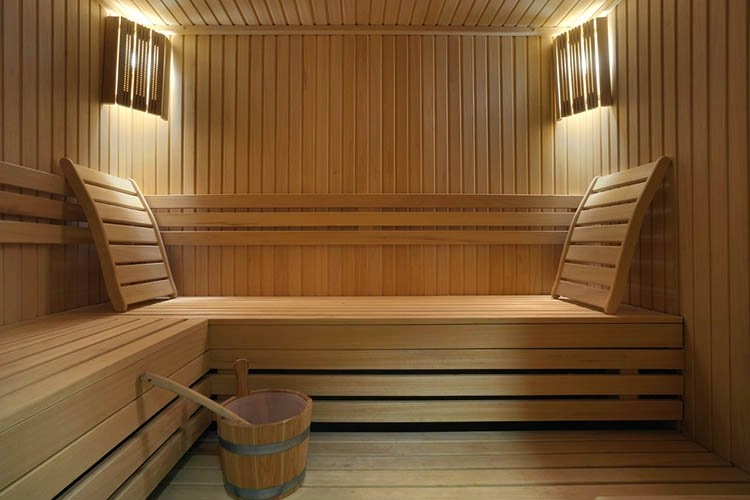Steam Rooms vs Saunas (Pros and Cons)
If you’re debating between adding a steam room or a sauna to your home, you’ll want to weigh up the pros and cons of each before deciding. Both provide health benefits and a place to relax and unwind at the end of the day. They also both provide a place to socialize or connect with loved ones.
Sweating is an important function of the body which allows the body to cool itself. Our bodies would overheat without a sweat. People have known this for millennia, and have looked to steam rooms and saunas to get their sweat on.
The question is, which is best? It might come down to personal preference. Here, we’ll discuss the pros and cons of the two to help you make an informed choice.
View this post on Instagram
Steam Rooms
A steam room will create a hot and wet tropical-like atmosphere. They are usually heated to temperatures ranging from 114F to 120F and deliver near 100% humidity.
Pros
- Steam is good for your skin. It stimulates the sweat glands which pushes out dirt, contaminants, and other potentially toxic materials
- The direct skin contact of hot steam helps relax tense, tired, and strained muscles
- The airborne steam gets into the lungs and acts as an expectorant, helping to clear airways
- The steam created helps create the desired atmosphere, making the experience feel more authentic
- It may help with weight loss as it burns calories
Cons
- Dehydration can happen quickly, making it necessary to have water on hand
- Pregnant women should not use steam rooms as it could be harmful. Please consult with a doctor
- High heat and prevalent moisture can promote the growth of mold, bacteria, and fungus
- The near 100% humidity means don’t bring anything into the steam room that can be damaged by water such as books, electronics, etc
- Elevated heat can raise the heart rate. Ask your physician before using a sauna if you have any health concerns
View this post on Instagram
Saunas
There are many health benefits of taking a sauna. A sauna generates dry heat reaching temperatures up to 160F and going as high as 195F.
A sauna can be either a dry sauna or a wet sauna. The difference is water being poured onto the heated rocks which creates steam. If you are using a dry sauna, you won’t have the steam and will have a hotter but less humid experience.
Pros
- The dry heat generated in a sauna stimulates the skin for better surface circulation. Remember, the skin is the largest organ in the body, so better circulation in the skin means better overall circulation
- Like a steam room, a sauna is good for aching muscles, but it can take longer for the therapeutic effect of the heat to penetrate muscles
- It may help with weight loss as it burns calories
Cons
- Dry, hot air can cause dry skin, especially during the colder months of the year. This can cause cracking and peeling
- Pregnant women may be able to use a sauna, but only for short periods
- Elevated heat can raise the heart rate
- Consult your physician before using a sauna if you have any health concerns
Heat vs Humidity
One major difference between saunas and steam rooms is heat and humidity. While steam rooms are cooler, they generate near 100% humidity. If you love the feeling of a steamy shower and sweating, a steam room might be for you.
Saunas are hotter but do not generate as much humidity (directly). While both saunas and steam rooms provide health benefits, if you have respiratory issues, steam rooms might be a better fit than a dry sauna.
Either way, make sure you stay hydrated with fresh water in a sauna or steam room and take breaks as needed.
Please consult your physician before starting a sauna or steam routine if you have any health issues or concerns.
Cost and Maintenance
According to Fixr.com, a full-sized 2-person sauna will cost up to $2,900 to build and install; and a comparable steam room will run you about $1,000 on top of that. So one benefit of a sauna is that it’s more budget-friendly.
The reasons for this include the fact that the apparatus for generating steam is more involved, more resource-intensive, and more difficult to maintain. A steam room needs a heat source, a vessel for water, and it must be sealed to prevent steam from escaping.
Steam rooms need to be cleaned and sanitized to prevent mold and fungus from taking hold. Interestingly, you might use the same infrared heater you could use to make a simple sauna and use it to dry the room thoroughly.
Saunas also need to be regularly cleaned and maintained. Most sauna heaters require little maintenance but stones should be inspected to help maintain airflow and heat.
Whether you choose a sauna or a steam room, you’ll get a relaxing way to stimulate the sweat glands and relax the body so either way, you’re doing something good for your lifestyle and health (and your property value).

